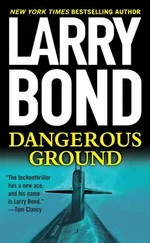Radimov nodded. “The batteries. Remember how they wouldn’t hold a charge, and we found those grounds and thought fixing them would solve the problem?” He nodded toward the cursing crewman. “Turov chased down the last of the shorts late last night, and the batteries still won’t hold a full charge. We’ve been running three different generators on them all night. They should glow in the dark.”
Priz’s main thruster motor was a power hog, even though she wasn’t supposed to leave the vicinity of the mother ship, they still had to maneuver to properly land and then mate with an escape hatch. Add to that power for the maneuvering thrusters, sonar, the interior lights, heat and atmosphere control; the energy requirements were far outstripping the batteries’ capacity. With a fresh charge before each trip, the batteries were theoretically supposed to be sufficient for almost six or seven hours.
“Of the thirty-two cells, less than half will hold a decent charge, about eighty percent. Of the rest, most are around fifty percent, and a few are as low as twenty-five percent — essentially useless.”
Gradev absorbed the report, calculated the implications. “Three hours?”
“At best, Captain,” Radimov answered. “We’ve still got those twelve new cells coming from storage, but there’s no guarantee they haven’t exceeded their service lives just sitting on the shelf. What will we tell Northern Fleet?”
He didn’t even have to think about it. “Nothing,” Gradev answered. His starpom’s expression was filled with surprise and concern. Gradev knew exactly what was going through Radimov’s mind and he attempted to reassure him. “We’re still working on the problem. We may yet find a solution. AS-34’s endurance should improve once the new cells are installed.”
Radimov was not convinced. “They don’t arrive until just before we sail. It takes hours to install a single cell, and we’ll be working in heavy weather.”
“The work can still be done well before we reach Severodvinsk’s location, if they find it at all. And three hours is more than enough for one trip. Priz will just have to have her batteries recharged more often. And let’s see what we can do about improving the individual cells’ capacities, get them back up to their old levels.”
The first officer looked confused. “They’re sealed units. We’re not supposed to tamper with their internal components.”
“Unseal one of the bad ones. They stopped making those batteries ten years ago. If we can’t find a way for them to hold more power, this will be AS-34’s last cruise.”
“And Northern Fleet doesn’t need to know this?” “We’ve had one visit by Vidchenko. We don’t need another.”
8 October 2008
0530/5:30 AM
Petr Velikiy was the fourth and last unit of the Orlan- class, or Kirov- class, as they were known by NATO. A nuclear-powered guided-missile cruiser, she was flagship of the Northern Fleet and would lead the rescue force.
On the bridge, Rear Admiral Vidchenko sat in one of the flag chairs and fidgeted. Now that he’d given the order to sortie, there was little to do.
The bridge was huge, especially for a submariner. A full fifteen meters across, the long row of windows in the front made Vidchenko think of a greenhouse more than a warship. The electronic consoles that displayed the ship’s functions didn’t begin to fill it up. Thinking of a submarine’s cramped central command post, Vidchenko had a sudden urge to play racquetball.
There were several clusters of officers on the bridge. Captain First Rank Chicherin actually commanded “Petya.” It was a prestige appointment, and Chicherin was widely regarded as a climber. His competence as a commander would never really be an issue, not with two higher levels of command embarked.
Chicherin was moving around a lot, trying to look busy while Rudnitskiy got underway. He kept going out onto the bridge wings, and staring at the rescue ship, as if that could speed its progress. Petr Velikiy would be next to leave.
Rear Admiral Ivan Kurganov, Commander of the Forty-third Missile Ship Division, was in charge of the task group, and Vidchenko watched him quietly chat with several of his staff. There was little for Kurganov to do either, but he did nothing much better than Chicherin. He would let the captain run his ship, but as the center of the task group, it would only go where Kurganov ordered.
Kurganov’s staff monitored the task group’s operations in flag plot, located in a separate space behind the bridge. Although Petr Velikiy was still tied up at the pier, for the admirals, the battle had already started. Escort vessels were searching the harbor for unwelcome observers. Western subs had lurked outside Russian bases many times before. Officers and crewmen in flag plot tracked the searchers’ progress as they scoured the water with their active sonar.
The storm would make acoustic searches almost futile, but Vidchenko and Kurganov agreed that it was worth the time and effort. The storm would also prevent Western satellites from watching the group’s departure. The formation also departed under total emission control; no military radars or communications systems were transmitting. They would not give the Americans a free ride. Delaying news of their departure meant the Americans couldn’t predict when the task group would arrive in the search area. Vidchenko thought that was good.
Vidchenko was in command of the entire search and rescue effort. This included not only Kurganov’s task group, but aircraft from shore bases and eventually the Norwegians, when they arrived. During this mission, he reported directly to Admiral Kokurin, commander of the Northern Fleet. And Vidchenko didn’t give a fig who Kokurin talked to.
He’d first met Kurganov when each had been given their assignments as part of the rescue. They’d gotten little sleep, not only preparing the ships for sea, but designing a search plan.
Kurganov was a Muscovite, urban and a little too worldly for Vidchenko’s tastes. He’d been born in the north, to a Navy family, but preferred Saint Petersburg to the nation’s capital. In spite of their different backgrounds, they’d got on famously, because they shared an utter distrust of the Americans and harbored deep suspicions about the U.S. submarine’s true role in the incident.
The surface admiral had drawn heavily on Vidchenko’s submarine experience. Together they’d developed an airtight search plan. They were searching for two subs: one that could not move, another that could.
After much discussion, they’d decided to head straight for the location provided by the Americans. They felt like prize fools for having to act on it, but they’d be bigger fools if they didn’t look there first.
They’d polished the plan now for two days, and if the tactics were slanted more toward ASW than search-and-rescue, it was hard to imagine that anyone on Severodvinsk was still alive. Part of Vidchenko wanted to believe that they were still alive, but that meant they were trapped, probably in the dark, certainly cold, breathing foul air and praying for help that might not come in time. He was a submariner, and you accepted that possibility every time you submerged, but it was a nightmare nobody wanted to think about. Part of him believed a quick end might be better.
And most of him just wanted to find the American submarine. What would happen after that depended on Severodvinsk’s fate.
Chicherin walked over to Kurganov and saluted. Vidchenko couldn’t hear the words, but saw line handlers moving on the main deck. Kurganov returned the salute, then walked over to Vidchenko’s chair. “We’re underway,” he reported. “And good luck to us all.”
Читать дальше












